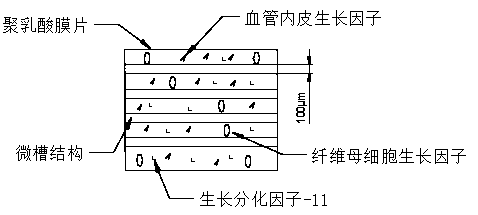Stent for directional induction of neural stem cell differentiation and preparation method thereof
A neural stem cell and directional induction technology, which is applied in the field of scaffolds for directional induction of neural stem cell differentiation and its preparation, can solve the problems of non-degradable and low efficiency of silica gel sheets, and achieve the goal of promoting adhesion growth, good application prospects, and restoring functionality Effect
- Summary
- Abstract
- Description
- Claims
- Application Information
AI Technical Summary
Problems solved by technology
Method used
Image
Examples
Embodiment 1
[0050] 1) Mix PLGA-(ASP-PEG)n-PLGA copolymer, 20 μg nerve growth factor and 20 μg nerve adhesion molecule
[0051] Add to 50ml PLGA solution; ultrasonically mix, and form a catheter by electrospinning, forming conditions: positive voltage 10kv, negative voltage 1.5kv;
[0052] 2) Using a femtosecond laser to engrave microgrooves with a groove width of 100 μm on the inner and outer walls of the catheter prepared in step 1), a groove depth of 10 μm, and a groove spacing of 50 μm, and sterilize by irradiation;
[0053] 3) Put the sterilized scaffold tube with microgrooves in step 2) into 5ml of neural stem cell solution, and then culture it in a 37°C, 5% CO2 incubator, induce culture for 14 days, and replace it every three days culture medium to observe cell proliferation and differentiation;
[0054] The results showed that the adhesion rate of the cells was 95%, and about 85% of the neural stem cells with an aspect ratio of about 5 grew along the orientation of the microgroove...
Embodiment 2
[0056] 1) Add PLGA-(ASP-PEG)n-PLGA copolymer, 20μg nerve growth factor and 20μg fibronectin to 50ml PLGA solution; ultrasonically mix, and form a catheter by electrospinning, forming conditions: positive voltage 10kv , the negative voltage is 1.5kv;
[0057] 2) Using a femtosecond laser to engrave microgrooves with a groove width of 100 μm on the inner and outer walls of the catheter prepared in step 1), a groove depth of 10 μm, and a groove spacing of 50 μm, and sterilize by irradiation;
[0058] 3) Put the sterilized scaffold tube with microgrooves in step 2) into 5ml of neural stem cell solution, and then culture it in a 37°C, 5% CO2 incubator, induce culture for 14 days, and replace it every three days culture medium to observe cell proliferation and differentiation;
[0059] The results showed that about 80% of neural stem cells with an aspect ratio of about 5 grew along the microgroove orientation.
Embodiment 3
[0061] 1) Add PLGA-(ASP-PEG)n-PLGA copolymer, 20μg nerve growth factor and 10μg fibronectin to 50ml PLGA solution; ultrasonically mix, and form a catheter by electrospinning, forming conditions: positive voltage 10kv , the negative voltage is 1.5kv;
[0062] 2) Using a femtosecond laser to engrave microgrooves with a groove width of 100 μm on the inner and outer walls of the catheter prepared in step 1), a groove depth of 10 μm, and a groove spacing of 50 μm, and sterilize by irradiation;
[0063] 3) Put the sterilized scaffold tube with microgrooves in step 2) into 5ml of neural stem cell solution, and then culture it in a 37°C, 5% CO2 incubator, induce culture for 14 days, and replace it every three days culture medium to observe cell proliferation and differentiation;
[0064] The results showed that about 75% of neural stem cells with an aspect ratio of about 5 grew along the microgroove orientation.
PUM
| Property | Measurement | Unit |
|---|---|---|
| thickness | aaaaa | aaaaa |
| diameter | aaaaa | aaaaa |
| diameter | aaaaa | aaaaa |
Abstract
Description
Claims
Application Information
 Login to View More
Login to View More - R&D
- Intellectual Property
- Life Sciences
- Materials
- Tech Scout
- Unparalleled Data Quality
- Higher Quality Content
- 60% Fewer Hallucinations
Browse by: Latest US Patents, China's latest patents, Technical Efficacy Thesaurus, Application Domain, Technology Topic, Popular Technical Reports.
© 2025 PatSnap. All rights reserved.Legal|Privacy policy|Modern Slavery Act Transparency Statement|Sitemap|About US| Contact US: help@patsnap.com



